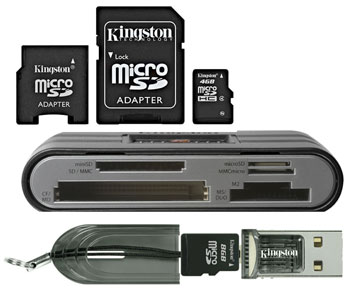Kingston Technology Company, Inc. is the world's largest independent manufacturer of memory products for desktops, laptops, servers, printers, and Flash memory products for PDAs, mobile phones, digital cameras, MP3 players and all sorts of other products. Kingston memory products have never let us down, and probably half the memory we use here at RuggedPCReview.com is from Kingston.
 With memory card standards proliferating and the various electronics in our lifes requiring different cards of all sizes, it's sometimes difficult to keep everything compatible. Fortunately, Kingston doesn't only make memory, they also make all sorts of readers and adapters that make transferring and saving files between notebooks, handhelds, cameras and smartphones easy and convenient.
With memory card standards proliferating and the various electronics in our lifes requiring different cards of all sizes, it's sometimes difficult to keep everything compatible. Fortunately, Kingston doesn't only make memory, they also make all sorts of readers and adapters that make transferring and saving files between notebooks, handhelds, cameras and smartphones easy and convenient.
The products you see in the picture to the right are absolutely indispensible. On top you see a Kingston 4GB microSDHC card next to a SD adapter and a miniSD adapter. This way, a single microSD card can be read in virtually any device that supports SDHC cards. This comes in incredible handy when you routinely deal with a variety of handheld electronics and has saved our collective behinds on a number of occasions. Below the cards is a Kingston 19-in-1 Media Reader (CF Type I (UDMA and PIO), CF Type II (UDMA and PIO), MicroDrive SD, SDHC, miniSD, miniSDHC, MMC, MMC+, RS-MMC, MMCmobile, MMCmicro, microSD, microSDHC, M2 (MemoryStick Micro), Memory Stick, Memory Stick Pro, Memory Stick Duo, Memory Stick Pro Duo). True, most people only use a few of those, but having this sturdy, reliable and inexpensive reader practically mandatory.
Below the reader is another cool and helpful gadget, the Kingston microSD USB adapter. This comes in handy when you frequently need to move data back and forth between devices that have USB but no microSD slot (like a notebook) and devics that use microSD cards but have no USB (like many smartphones).
Check out Kingston Technology's Flash Memory site to get an idea of all the products.
As a brief refresher on all the SD card family formats:
MMC flash memory cards were introduced in 1997 by Siemens and SanDisk. MMC stands for MultiMediaCard. They measure 32 x 24 x 1.4 mm, have 7 pins and no write-protect tab. They've largely been replaced by SD cards. MMC cards fit into SD card slots, but not the other way around.
RS-MMC stands for "Reduced Size MultiMediaCard. They measure 24 x 18 x 1.5 mm and were introduced in 2004. They were mainly used in some Nokia and Siemens smartphones, but are not much of a factor.
MMCPlus describes full-size MMC cards (32 x 24 x 1.4 mm) that are running at higher speeds. They were introduced in 2005.
MMCmobile uses the reduced size form factor (24 x 18 x 1.5 mm) but is running at the quicker speeds specified in Version 4.x of the MMC standard. There is no write-protection switch.
MMCmicro measures 14 x 12 x 1.1 mm, just a bit different from microSD and have different pin-outs. They can be used in MMC and SD card slots with adapters.
SD, or Secure Digital, cards were developed by Toshiba, SanDisk and Matsushita, and have been available since 2000. They measure 32 x 24 x 2.1 mm, have 9 pins and a write-protect switch. Though original conceived for flash memory storage. SD caard slots are popular because they can also be used for peripherals and cards that support the SDIO (Secure Digital Input Output) standard. SD cards are now available with capacities of 8GB.
SDHC stands for Secure Digital High Capacity and uses the same 32 x 24 x 2.1mm size as standard SD cards. However, SDHC cards use different memory aaddressing and can come in sizes up to 32GB. They only work in SDHC-compatible devices.
microSD, created by SanDisk in 2005 and originally called Trans-Flash, measures 15 x 11 x 0.7 mm and is probably the smallest memory card currently on the market. It's meant as removable flash memory and used primarily in cellphones, some handheld game consoles, GPS systems, music players and so on. As of May 2007, microSD is available with capacities up to 4GB, though Samsung announced an 8GB card. They have 8 pins and no write-protect switch.
miniSD was created by SanDisk in 2003 and measures 21.5 x 20 x 1.4 mm. They were created for use in devices where a standard SD Card was already considered to big, such as small digital cameras, music players or smartphones. miniSD cards are available in capacities up to 4GB. They have 11 pins and no write-protect switch.
As you can see, that's a whole lot of card formats, and though many look almost identical and some are compatible to some extent, it can be a nightmare to read them in a PC or notebook if you have devices that use various types of cards. Having the necessary readers and adapters definitely helps.


